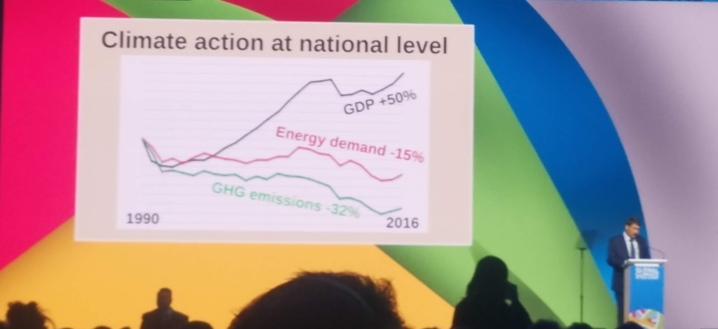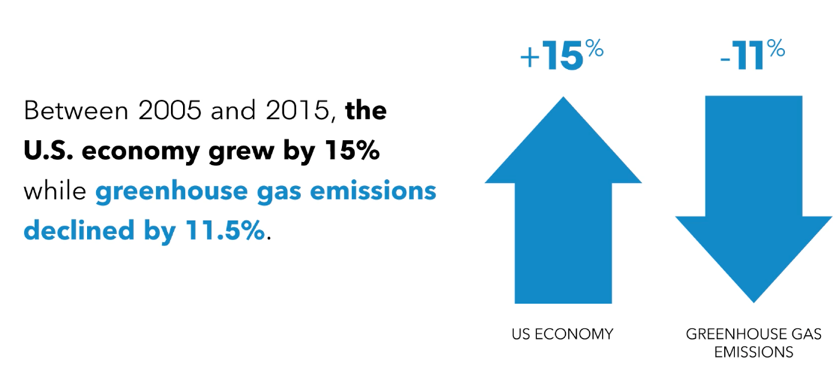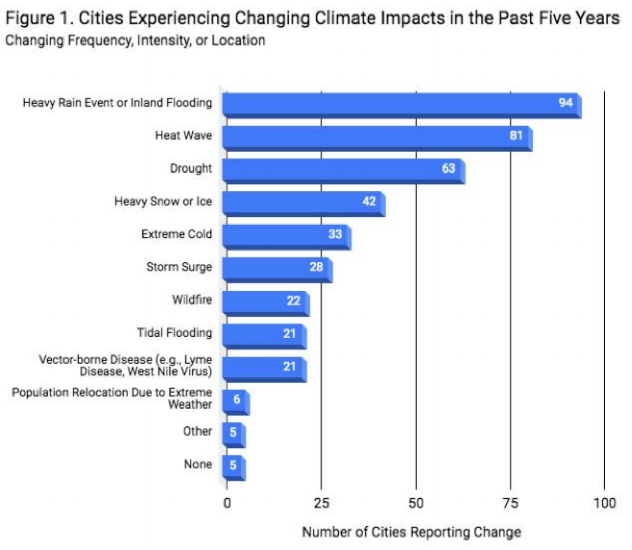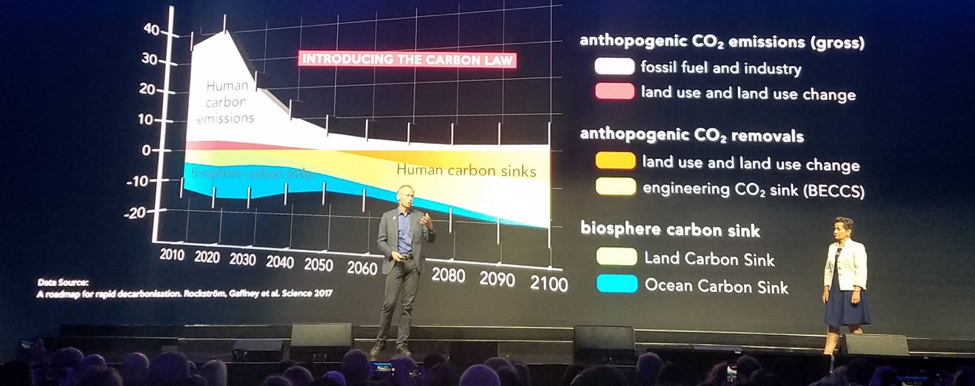The View from the Summit: United for Climate Action
The problem can become our salvation if we open our hearts and minds.
Governor Jerry Brown
More than 4,000 people – local leaders, citizens, businesses, activists and government officials – from all over the world gathered for the Global Climate Action Summit earlier this month to push for an acceleration of climate action. Thousands more climate advocates joined in at the dozens of other summit affiliate events (like the recent California Adaption Forum, organized by the Local Government Commission and the State of California).
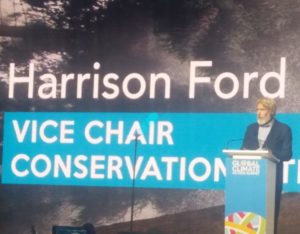
Amid the summit’s star-studded show, which included Harrison Ford, Alec Baldwin, Dave Matthews and Jane Goodall as well as political and corporate heavyweights such as Governor Jerry Brown, Paris Mayor Anne Hidalgo, Los Angeles Mayor Garcetti, former New York City mayor Michael Bloomberg and NextGen founder TomSteyer, were local, regional and state leaders getting downto the practical nuts-and-bolts tasks of creating meaningful change in their communities and in their industries.
Several major takeaways emerged from the whirlwind of the summit in San Francisco and the more-than-350 affiliate events around California and the world:
- Subnational entities working together can have a significant cumulative impact on climate change and our ability to strengthen the resiliency of our communities and industries.
- Economic growth and prosperity need not operate in opposition to climate action, they are in fact intrinsically intertwined.
- Transportation-related emissions remain a major challenge – our Achilles heel.
- Climate change is a humanitarian threat. Certain demographic groups – among them, women and indigenous communities around the globe – will bear the brunt of climate consequences, and they should play a key role in shaping solutions that respect their unique challenges, roles and cultures.
- Major economic, infrastructure and social changes will be needed to avoid the most catastrophic impacts of climate change; however, we have good reason for hope based on the actions we are taking now and committed to for the future.
The expanding role of sub-nationals
Subnational leadership has always been critical to driving innovation. Local and regional leaders are closest to the problems and move more quickly to develop pilot programs, implement innovative approaches, and make targeted use of technological advances that can provide proof of concept and be scaled with state (and eventually federal) regulations, funding resources and legislative guidance.
More than 50% of the world’s population live in cities today, and it is projected that two-thirds of the global population will live in urban areas by 2050. We’re already seeing these local leaders taking climate action, and many new commitments were unveiled at summit forums.
The Under2 Coalition now includes 222 governments – representing over 43% of the global economy $34 trillion in GDP and 1.3 billion people committed to limiting emissions to under 2 tons per capita to keep global temperature rises to under 2°C, in line with climate science.
The mayors of 19 cities – who preside over 130 million city-dwellers – from Copenhagen to Johannesburg to Tokyo made a net-zero carbon pledge for all new buildings by 2030.
In the U.S., states, cities and businesses representing more than half the U.S. economy and population have adopted greenhouse gas emissions-reduction targets and a similar portion have declared their support for the Paris Agreement. If these non-federal actors were a country, their economy would be the third-largest in the world.

Economic and Climate Interdependencies
Demonstrating that climate action is good business, the summit’s diverse participants described how economic growth and climate actions can create transformative synergies.
Twenty-one companies announced the launch of the Step Up Declaration, a new alliance dedicated to harnessing the power of emerging technologies to help reduce greenhouse gas emissions across all economic sectors and ensure a climate turning point by 2020. These companies included Bloomberg – which committed to integrate climate risk and opportunity analytics across all financial products by 2020 – and Salesforce – which is dedicated to achieving 100% renewable energy by 2022 and LEED V4 Platinum standards and Net Zero Carbon Buildings certification for all major new offices after 2020.
Sony, McKinsey Group, WeWork and the Royal Bank of Scotland agreed to source 100% of their electricity from renewables, joining some 140 other companies.
Starbucks touted its goal for 10,000 “greener” stores by 2025, which the coffee giant says will save $50 million on utility costs over the next decade.
Levi Strauss will cut greenhouse gas emissions from in facilities it owns by 90% by 2025.
”No planet, no business.” – Alexandra Palt, L’Oreal
In the realm of healthcare, Dignity Health, Kaiser Permanente, Providence St. Joseph Health and Sutter Health, four of the state’s largest health systems representing 107 California hospitals and serving more than 20 million patients in the state, formed the California Health Care Climate Alliance last month “to protect the public from the health impacts of climate change and to work with policymakers in Sacramento to support the state’s climate goals.”
Alliance members have committed to reducing their greenhouse gas emissions and transitioning to 100% clean energy. Their combined commitments will result in a projected reduction of more than 1.1 million metric tons of CO2, equal to taking 235,546 cars off the road each year.
Kaiser Permanente announced a 180-megawatt power purchase agreement that will help meet its goal of carbon neutrality by 2020, which “will enable the construction of utility-scale solar and wind farms, and one of the country’s largest battery energy storage systems.”
The Investor Agenda was launched to “accelerate and scale up” action to support the Paris Agreement. Numbering some 400 investor members (including CalPERS), the initiative represents $32 trillion in assets.
During the summit, the Global Green Bond Partnership was formed to “support efforts of sub-national entities such as cities, states, and regions, corporations and private companies, and financial institutions to accelerate the issuance of green bonds.” The partnership is backed by the World Bank, IFC, Ceres, ICLEI-Local Governments for Sustainability, the Global Covenant of Mayors for Climate and Energy, and other green-finance organizations.
Climate Action 100 counted 296 investors seeking to help some of the worst emitters to clean up their act.
Mayor Bill DeBlasio committed to double the climate-solutions-related investments of New York City’s pension funds to $4 billion over the next three years. That increase, supporting renewable energy, energy efficiency and other measures, would represent 2% of the fund’s existing $195-billion portfolio.
Other presentations at the summit highlight progress achieved – and momentum for new opportunities – in other parts of the world that provide encouraging signposts for these efforts.
Demonstrating that “green” can create economic-environmental synergies over an extended period, Hungary has generated a 50% increase in GDP, while reducing energy demand by 15% and cutting greenhouse gas emissions by 32% between 1990-2016.
California reached its 2020 climate change goal early, while building one of the world’s largest and strongest economies, proving that climate action and vibrant economic development can not only coexist, they can thrive.

At the national level, the U.S. economy has also shown that we can grow our economy (as measured by Gross Domestic Product) while reducing greenhouse gas emissions.
Across the pond, The Netherlands shared a goal by 2050 to become a “full circular economy,” aimed at reducing waste by using resources as long and fully as possible, then recovering any remaining outputs to put toward new uses.
Rapid results from or tackling short-lived pollutants
Summit attendees were briefed on the threat of short-lived climate pollutants (SLCP) by global policy leaders, technologists and scientists, including Amory Lovins from the Rocky Mountain Institute, and Dr. Veerabhadran Ramanathan from UC San Diego. The speakers highlighted how SLCPs – methane, black carbon and halocarbons such as hydrofluorocarbons – act as highly potent climate forcers.
Compared to CO2 and other long-lived climate pollutants, short-lived climate pollutants trap far more heat on a gram-to-gram basis despite a much shorter lifespan in the atmosphere. Methane, for example, is responsible for about 20-25% of current global climate warming.
Reducing these emissions can significantly reduce the rate of climate change and is necessary to meet Paris Agreement goals. At present rates, these gases, combined with CO2 emission levels, leave us with a 50% probability of crossing the threshold for dangerous global warming within the next 35 years.
The United Nations’ 2017 Emissions Gap Report indicates that a collection of cost-effective strategies could virtually eliminate hydrofluorocarbon emissions by 2035, and reduce methane emissions by one-third and black carbon by 70% below current levels by 2030. For example, the International Energy Agency and EDF reported that nearly half of methane emitted from oil and gas operations globally can be reduced at essentially zero net cost while also improving mine and pipeline safety. An estimated 2,500 dairy and swine farms across the U.S. could also support anaerobic digesters that produce renewable gas and other products worth billions of dollars per year.
California is already taking leadership on this issue through its 2017 SLCP Reduction Strategy. Developed pursuant to SB 605 and SB 1383, the strategy lays out a range of regulatory, incentive-based and market-supportive options to accelerate statewide reductions in SLCP emissions 40-50% below 1990 levels by 2030.
Natural resources: Our climate allies
Reducing emissions is probably not enough to keep the climate within safe boundaries. We also need to draw more carbon out of the atmosphere. Restoring ecosystems through “natural climate solutions” can deliver 30% of the climate solutions needed to keep global temperature rise below 2°C by 2030— these solutions are available today and are affordable and scalable. However, natural climate solutions currently receive less than 3% of climate funding, according to ForgottenSolutions.org. Summit speakers from Jane Goodall to Harrison Ford forcefully made the argument that we need much greater investment in natural climate solutions.
Worldwide, forests and terrestrial soils store more than 2-1/2 times as much carbon as the atmosphere. And with some adjustments to how we manage our landscapes, these natural resources could emit less carbon and store much more, according to the World Economic Forum. Furthermore, a working forest, when sustainably managed, can be both a carbon sink and a source of jobs. Smarter forestry practices, like reduced impact logging for carbon, can maintain timber harvest while also preserving more standing trees. Meanwhile, changes in agricultural practices can reduce carbon emissions and enhance the health and carbon content of soils to increase crop yields.
Investing in natural climate solutions is cost-effective and profitable, and can be an economic driver. Globally, the nascent restoration economy is estimated to produce at least $9 billion in annual economic activity, with the potential to grow much larger. In the U.S., these companies employ more than 120,000 people – more than the workforce in American iron and steel production. Boosting the wider economy and improving local resiliency through natural climate strategies could cost less than $10 per ton of CO2 equivalent.
Moving transportation toward climate action
Transportation is a significant contributor to climate change. It is also now on the cusp of major structural changes – in electric, autonomous, shared vehicles and networks – that can create significant climate benefits if done well.
California met its 2020 goal despite our relative lack of progress on transportation–related emissions. The number of vehicle miles travelled (VMT) went up 2%, despite the targets called for within AB 32 and SB 375. While electric vehicles will certainly be part of the solution, the turnover rate from its fossil-fueled predecessors will be slow. In the meantime, mobility costs are down and, as a result, people are consuming more.
All the while, with the converging threats of increased VMT and the “convenience” factor and empty-vehicle potential of autonomous vehicles, the pressure to build affordable housing everywhere could further lengthen commutes and congestion.
A continued increase in greenhouse gas emissions from transportation is a very serious threat.
In response, city representatives, including those from Tokyo, Seoul, Warsaw, Rotterdam, Oslo and Honolulu, signed the C40 Fossil-Fuel-Free Streets Declaration ahead of the Global Climate Action Summit, joining a number of cities like London, Paris and Los Angeles who have already signed up to increase the number of zero-emission vehicles in their city fleets, and improve rates of walking, bicycling and public transit.
Targets for zero-emissions cars were set by 26 businesses, states, cities and regions, taking up the new #ZEVchallenge. ”Range anxiety“ could become a thing of past if ChargePoint, EVBox, Southern California Edison, FLO and National Grid meet their commitments to install 3.5 million EV chargers in the U.S. by 2025.
Addressing the humanitarian threat of climate change
Extreme climate-related disasters in poor countries has shot up in the last 25 years, according to Oxfam International Executive Director Winnie Byanyima. As a consequence, global hunger is on the rise again, reversing close to a decade of progress in ending hunger.
Worldwide, 80% of climate refugees are women, and women are three to five times more at-risk from climate impacts.
“If we are serious about keeping global warming below 1.5°C – meaning net zero global emissions by mid-century – we need to re-think the very purpose of our public policies and of our businesses,” said Winnie Byanyima, Oxfam International’s executive director. “We need a more human economy – one that prioritizes the many over the few, and keeps within the boundaries our planet can bear.”
Later this year, 49 of the most vulnerable countries are hosting the world’s first virtual climate summit. They’ve agreed to a vision of 100% renewable energy by 2050.
At the summit, the Governors’ Climate and Forests Task Force – comprising 34 governors from nine nations, including Brazil, Indonesia, Nigeria, Spain and the United States – also described its commitment to partner with indigenous “forest peoples” on forest conservation and climate mitigation. Pilot projects toward that end are resulting in “reduced deforestation, increased benefit sharing, and jointly created sustainable, low-emissions economic development.”
Hope and change: Climate threat, climate opportunity
The majority of scientists and community members alike agree the threat of climate change is very real. Across the United States, cities are reporting that they have experienced tangible climate impacts over the past five years, particularly heavy rain, flooding and heat waves that have increased in frequency and/or intensity, and have varied from historical location.
These climate impacts are driving not just commitments but also measurable greenhouse gas emissions. Globally, 27 big cities, including San Francisco and Los Angeles, have seen greenhouse gas emissions fall over the past five years and are now at least 10% below their peak levels, according to a C40 Cities report.
With all the climate commitments made and inspirational stories shared, the question remains can we change in time?
Johan Rockström, director of the Stockholm Resilience Centre, gives us a 66% chance of staying under the targeted 2°C threshold needed to avoid the most catastrophic and irreversible impacts of climate change – if we do all of the following:
- Bend the curve on emissions by 2020 and cut emissions in half every decade towards a fossil-fuel economy by mid-century (shown in white in the chart below).
- Transform the food system from a carbon emitter to a carbon sink through an agricultural revolution (the red/orange area).
- Invest in carbon capture and storage to address all the carbon currently in the system (the yellow area).
- Maintain negative carbon sinks and ecosystems so we have resilience in our oceans, coral reef systems and terrestrial ecosystems (the yellow/blue area).
The imperative for action is urgent to accomplish these goals, but there’s good reason to hope we can change – and that those changes will make the difference before it’s too late.
Resources
Mayor’s Leading the Way on Climate: How Cities Large and Small are Taking Action 2018. Alliance for a Sustainable Future: A joint effort by The U.S. Conference of Mayors and the Center for Climate and Energy Solutions (C2ES). https://www.c2es.org/site/assets/uploads/2018/09/mayors-leading-way-on-climate-2018.pdf
California’s Fourth Climate Change Assessment includes statewide, regional and technical reports: http://www.climateassessment.ca.gov/
Catalyzing action through new online resources
The Fourth Assessment funded the development and enhancement of several tools and resources to support climate action:
Cal-Adapt: Cal-Adapt is the State’s portal for providing easy access to the climate change projections that underpin the Fourth Assessment, enabling data download and visualizations of climate scenarios at the local level as well as wildfire projections for the entire state. Visualization tools for key climate variables and many data sets are available to the public.
Cal-Heat: The California Heat Assessment Tool is a new tool funded by the Fourth Assessment to inform the planning efforts of local public health officials. The tool provides health-informed heat thresholds for communities across California and examines how the frequency and severity of local heat waves are expected to change over time due to climate change.
USGS Coastal Storm Modeling System (CoSMoS): The Fourth Assessment funded an expansion of the USGS CoSMoS model, which projects complex coastal dynamics in a variety of coastal flooding scenarios. This includes an update to the Our Coast Our Future (OCOF) Flood Viewer, developed by Point Blue Conservation Science, which provides a web tool to view CoSMoS flood-hazard projections.
walrus.wr.usgs.gov/coastal_processes/cosmos/
USGS Hazard Exposure Reporting and Analytics (HERA): The Fourth Assessment funded expanded coverage of the USGS HERA web tool, which links the USGS CoSMoS flood projections to socioeconomic impacts in coastal communities.
Adaptation Capability Advancement Toolkit (Adapt-CA): The Adaptation Capability Advancement Toolkit (Adapt-CA) helps local governments overcome common organizational barriers and advance their capability to implement climate-adaptation measures. The Toolkit can help local governments assess their existing capabilities for climate adaptation and identify concrete actions to advance their capabilities for more effective planning and implementation of climate-adaptation activities.
California Emergency Response Infrastructure Climate Vulnerability Tool (CERI-Climate): California owns or operates more than 600 facilities critical to the state’s ability to respond to disasters. CERI-Climate is a decision-support tool that helps evaluate the risk to these facilities from flood and wildfire, and how climate change may affect these risks.
public.tableau.com/profile/rand4185#!/vizhome/CJ302-1000_CERI-Climate_20180227/Title
Local Government Commission Newsletters
Livable Places Update
CURRENTS Newsletter
CivicSpark™ Newsletter
LGC Newsletters
Keep up to date with LGC’s newsletters!
Livable Places Update – April
April’s article: Microtransit: Right-Sizing Transportation to Improve Community Mobility
Currents: Spring 2019
Currents provides readers with current information on energy issues affecting local governments in California.
CivicSpark Newsletter – March
This monthly CivicSpark newsletter features updates on CivicSpark projects and highlights.

